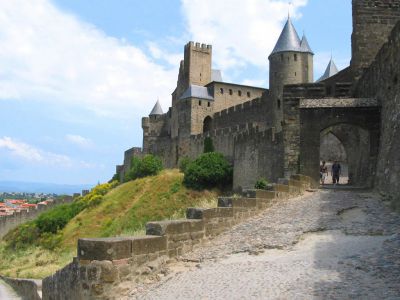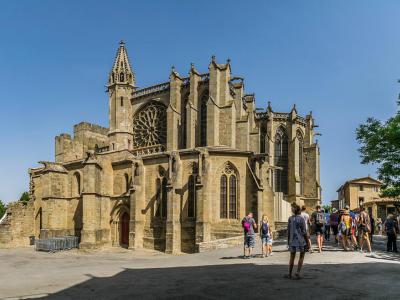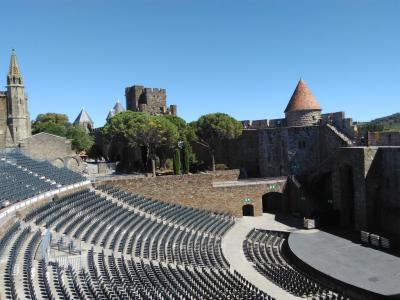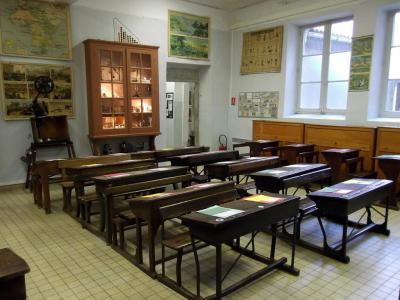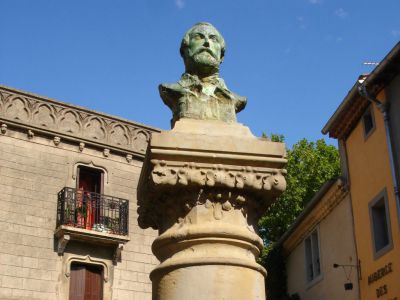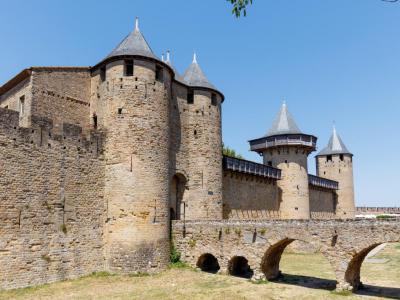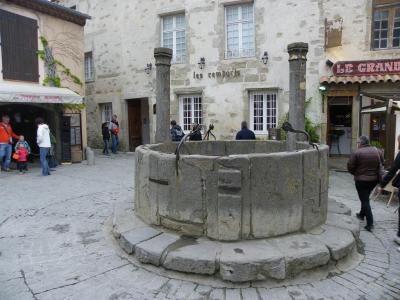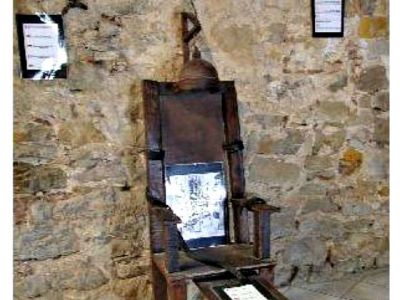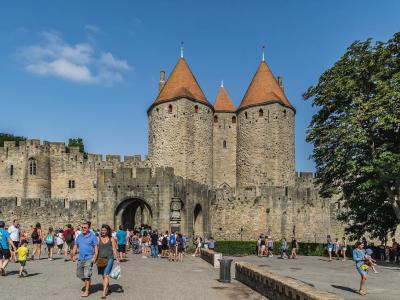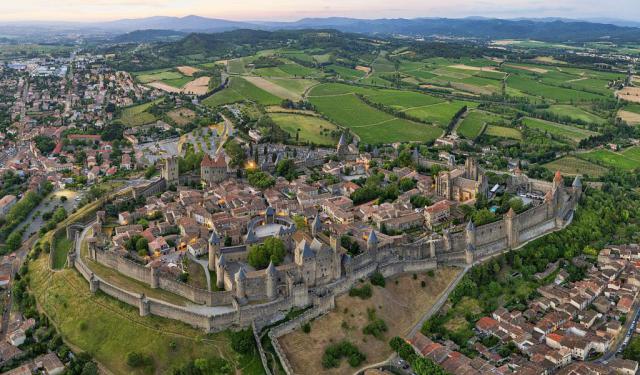Medieval City of Carcassonne Walking Tour (Self Guided), Carcassonne
A pig full of wheat was thrown off the battlements. The lady commanding the fortress was a Muslim. The besieging Christians knew Muslims do not eat pig. What is more, the defenders must have plenty of food if they could feed wheat to a pig and throw it over the walls. The siege had lasted five years. The attackers were starving. They left.
Many stories are told about the fortified medieval citadel in the French city of Carcassonne. It looms on the east bank of the river Aude. The fortress city was founded in Roman times. Walls, towers and barbicans have been added to and improved over time. Today it looks as it did centuries ago.
The citadel, or Cite, as it is known locally, is wrapped in two concentric stone walls that stretch around it for two miles. There are 52 towers with pointed Gothic or slanted Roman roofs. In the surrounding vineyards comes the scent of pine, spices and flowers. This is the garrigue, the scent of southern France.
The Cite is the largest and best preserved medieval fortress in Europe. Within its walls are churches, a basilica, a castle and a meandering maze of cobbled streets lined with ancient buildings and squares. Not to be missed are Basilica Saint Nazaire, the count's castle, the Narbonnaise Gate and the Museum of the Inquisition.
Auto traffic is essentially banned in the Cite but Parking is available near the Narbonne Gate or Aude Gate.
Gustave Nadaud, a French poet wrote about Carcassonne:
"My prayer will ne'er fulfilment know
I never have seen Carcassonne,
I never have seen Carcassonne!"
Don't grieve like Gustave, see the walls and Towers of Carcassonne.
Many stories are told about the fortified medieval citadel in the French city of Carcassonne. It looms on the east bank of the river Aude. The fortress city was founded in Roman times. Walls, towers and barbicans have been added to and improved over time. Today it looks as it did centuries ago.
The citadel, or Cite, as it is known locally, is wrapped in two concentric stone walls that stretch around it for two miles. There are 52 towers with pointed Gothic or slanted Roman roofs. In the surrounding vineyards comes the scent of pine, spices and flowers. This is the garrigue, the scent of southern France.
The Cite is the largest and best preserved medieval fortress in Europe. Within its walls are churches, a basilica, a castle and a meandering maze of cobbled streets lined with ancient buildings and squares. Not to be missed are Basilica Saint Nazaire, the count's castle, the Narbonnaise Gate and the Museum of the Inquisition.
Auto traffic is essentially banned in the Cite but Parking is available near the Narbonne Gate or Aude Gate.
Gustave Nadaud, a French poet wrote about Carcassonne:
"My prayer will ne'er fulfilment know
I never have seen Carcassonne,
I never have seen Carcassonne!"
Don't grieve like Gustave, see the walls and Towers of Carcassonne.
How it works: Download the app "GPSmyCity: Walks in 1K+ Cities" from Apple App Store or Google Play Store to your mobile phone or tablet. The app turns your mobile device into a personal tour guide and its built-in GPS navigation functions guide you from one tour stop to next. The app works offline, so no data plan is needed when traveling abroad.
Medieval City of Carcassonne Walking Tour Map
Guide Name: Medieval City of Carcassonne Walking Tour
Guide Location: France » Carcassonne (See other walking tours in Carcassonne)
Guide Type: Self-guided Walking Tour (Sightseeing)
# of Attractions: 9
Tour Duration: 1 Hour(s)
Travel Distance: 1.2 Km or 0.7 Miles
Author: Linda
Sight(s) Featured in This Guide:
Guide Location: France » Carcassonne (See other walking tours in Carcassonne)
Guide Type: Self-guided Walking Tour (Sightseeing)
# of Attractions: 9
Tour Duration: 1 Hour(s)
Travel Distance: 1.2 Km or 0.7 Miles
Author: Linda
Sight(s) Featured in This Guide:
- Porte de l'Aude (Aude Gate)
- Basilique Saint-Nazaire (Basilica of Saint-Nazaire)
- Jean Deschamps Theatre
- Musée de l'Ecole (School Museum)
- Jean-Pierre Cros-Mayrevieille Monument
- Château et Remparts (Castle and Ramparts)
- La Grand Puit (The Big Well)
- Musee de L'Inquisition (Museum of the Inquisition)
- Porte Narbonnaise (Narbonnaise Gate)
1) Porte de l'Aude (Aude Gate) (must see)
Partially destroyed in 1816 to make room for the Saint Gimer church, the ramp and crenelated walls of this gate remain overlooking the river Aude. The gate has been used as a locale for several "period" films, including The Visitors, Robin Hood, Prince of Thieves and Le Corniaud.
The Aude Gate, once called the Gate of Toulouse, pierced the Visigothic wall in the 12th century. The semicircular arch on the outside looks to be from this era, particularly with reference to its appearance and material used in construction.
The ramp is dominated by two towers. The intruder was forced to turn sharply to reach the Gate. In front of the gate there was no bridge or ditch to protect attackers. The space was untenable for an enemy. It was basically an armed trap, controlled on all sides from above.
Aude Gate is more impressive as an entrance to the Cite than other gates. It is at the peak of a steep path not open to traffic. It requires a rather steep climb but it is more tranquil than the usual tourist entry points.
The Aude Gate, once called the Gate of Toulouse, pierced the Visigothic wall in the 12th century. The semicircular arch on the outside looks to be from this era, particularly with reference to its appearance and material used in construction.
The ramp is dominated by two towers. The intruder was forced to turn sharply to reach the Gate. In front of the gate there was no bridge or ditch to protect attackers. The space was untenable for an enemy. It was basically an armed trap, controlled on all sides from above.
Aude Gate is more impressive as an entrance to the Cite than other gates. It is at the peak of a steep path not open to traffic. It requires a rather steep climb but it is more tranquil than the usual tourist entry points.
2) Basilique Saint-Nazaire (Basilica of Saint-Nazaire) (must see)
In the sixth century during the era of the Visigoths, Theodoric the Great presided over the construction of the original church destined to occupy the site of the Basilica of Saint-Nazaire. A Carolingian cathedral later occupied the space but it was destroyed in the 1100s. In the 13th century the cathedral was reconstructed in a Gothic style.
It was the cathedral of Carcassonne until 1803, when it ceded that title to Catedral Saint-Michel de Carcassonne. The church was classified as a historical monument in 1840. In 1898 the church was elevated to the rank of minor basilica.
The basilica is laid out in a Latin cross configuration. Its interior length is 226 feet. The nave is 53 feet wide and the transept measures 115 feet. The tripartite nave is Romanesque and easily the oldest part of the church. The main entrance in the north wall is made of two doors framed by five receding arches also in the Romanesque style.
The west wall has a fortress like facade as with most languedoc-roussillon churches of that period. The transept and choir are Gothic. The central stained glass window of the choir is from 1280. It is one of the oldest such windows in France. With the upper trefoils it shows the life of Jesus in 16 pictures.
It was the cathedral of Carcassonne until 1803, when it ceded that title to Catedral Saint-Michel de Carcassonne. The church was classified as a historical monument in 1840. In 1898 the church was elevated to the rank of minor basilica.
The basilica is laid out in a Latin cross configuration. Its interior length is 226 feet. The nave is 53 feet wide and the transept measures 115 feet. The tripartite nave is Romanesque and easily the oldest part of the church. The main entrance in the north wall is made of two doors framed by five receding arches also in the Romanesque style.
The west wall has a fortress like facade as with most languedoc-roussillon churches of that period. The transept and choir are Gothic. The central stained glass window of the choir is from 1280. It is one of the oldest such windows in France. With the upper trefoils it shows the life of Jesus in 16 pictures.
3) Jean Deschamps Theatre
On the morning of June 3, 1908, Doctor Jean Sempre, assistant to the Mayor of Carcassonne and a member of the Society of Arts and Sciences, firmly suggested in council that what the city required at this point was none other than a huge open air theatre.
The theatre would be built on the site of the ruined cloister of Saint-Nazaire. During the siege of 1209, the cloister was partially destroyed to reinforce the fortifications and walls of the town. Dr Sempre pointed out that the space formerly occupied by the cloister would make a spanking open air theatre.
"We are persuaded that a [great] tragedy done in this arena...would produce a grandiose effect and attract a great number of spectators to Carcassonne....on the other hand, from a practical point of view, it would be a notable source of benefits for the merchants of the city." So the the open-air theatre of the Cite was born.
The theatre is scooped out of a hillside like an ancient amphitheater of classical times. Seating capacity is about 5,000 souls seated on chairs and benches. In 1957 the theatre was renamed in honor of actor Jean Deschamps, a world famous stage and film performer and a member of the Comedie Francais.
Dr Sempre's vision came true. The theatre over the years has hosted many great plays and events. Since the name change The Festival of the Cite is presented here annually in the summer.
The theatre would be built on the site of the ruined cloister of Saint-Nazaire. During the siege of 1209, the cloister was partially destroyed to reinforce the fortifications and walls of the town. Dr Sempre pointed out that the space formerly occupied by the cloister would make a spanking open air theatre.
"We are persuaded that a [great] tragedy done in this arena...would produce a grandiose effect and attract a great number of spectators to Carcassonne....on the other hand, from a practical point of view, it would be a notable source of benefits for the merchants of the city." So the the open-air theatre of the Cite was born.
The theatre is scooped out of a hillside like an ancient amphitheater of classical times. Seating capacity is about 5,000 souls seated on chairs and benches. In 1957 the theatre was renamed in honor of actor Jean Deschamps, a world famous stage and film performer and a member of the Comedie Francais.
Dr Sempre's vision came true. The theatre over the years has hosted many great plays and events. Since the name change The Festival of the Cite is presented here annually in the summer.
4) Musée de l'Ecole (School Museum)
In 1980 Francis Loubes was able to materialize his passion for the French primary school system. He collected materials, he restored furniture and objects from the grand old days of elementary education for children aged six to sixteen. The objects piled up. Eventually he needed a museum.
Helped by the city of Carcassonne, he set up in the old city community school. There he created The Association of the School Museum. The museum exhibits are housed in five halls located on Plo Street.
The time of the Third and Fourth Republics in France was a rich era for primary education. Teaching aids used from 1880 to 1960 may be seen in the five rooms of the museum. There are interactive classes for adults and children where one can experiment with old quill pens or the famous Gallic stick pen called the "sergeant major."
There are mannequins of students in period clothing using the classrooms. One may be seen wearing a cloth hat labeled "Ane" ("ass"). No old time school is without a "Dunce" hat. When using the old pens and purple ink, don't wear white.
Topics covered in these schools would include Morals and Civics, Reading and Writing, Geography, especially French, and History, especially French again. Science studies taught were Physics and Math, Agriculture, Hygiene, and Industrial Arts. Classes in Drawing, sculpting and music were available. And of course there was Physical Ed.
Helped by the city of Carcassonne, he set up in the old city community school. There he created The Association of the School Museum. The museum exhibits are housed in five halls located on Plo Street.
The time of the Third and Fourth Republics in France was a rich era for primary education. Teaching aids used from 1880 to 1960 may be seen in the five rooms of the museum. There are interactive classes for adults and children where one can experiment with old quill pens or the famous Gallic stick pen called the "sergeant major."
There are mannequins of students in period clothing using the classrooms. One may be seen wearing a cloth hat labeled "Ane" ("ass"). No old time school is without a "Dunce" hat. When using the old pens and purple ink, don't wear white.
Topics covered in these schools would include Morals and Civics, Reading and Writing, Geography, especially French, and History, especially French again. Science studies taught were Physics and Math, Agriculture, Hygiene, and Industrial Arts. Classes in Drawing, sculpting and music were available. And of course there was Physical Ed.
5) Jean-Pierre Cros-Mayrevieille Monument
In 1849 the French government decreed the fortifications of Carcassonne must be demolished. They were crumbling and unsightly and hell to dust. Even Napoleon had Carcassonne struck off the list of official fortifications.
But the government picked the wrong town to start a fight. They picked wrong town and the wrong mayor. Jean-Pierre Cros-Mayrevieille was an official inspector of historical monuments, he was deeply passionate about his city. The government had its decree but Jean-Pierre he had the city behind him and he had influential friends.
Prosper Merimee, a prominent writer and fellow inspector of historical monuments, was equally passionate about preservation. Merrimee had been involved in several controversial restoration efforts including Paris' Notre-Dame Cathedral. Together they would hold the fort. They succeeded. The government reversed itself.
Gothic revivalist architect Eugene Viollet-le-Duc was in town, working at restoring the basilica of Saint-Nazaire. He undertook the needed restorations.
A memorial to Jean-Pierre was dedicated in 1911. It is an imposing bronze bust of him atop a bronze column. The base of the column is an accurate sculpture of the walls and fortifications of Carcassonne. The memorial was erected by "ses concitoyens et ses amis" ("his fellow citizens and friends").
But the government picked the wrong town to start a fight. They picked wrong town and the wrong mayor. Jean-Pierre Cros-Mayrevieille was an official inspector of historical monuments, he was deeply passionate about his city. The government had its decree but Jean-Pierre he had the city behind him and he had influential friends.
Prosper Merimee, a prominent writer and fellow inspector of historical monuments, was equally passionate about preservation. Merrimee had been involved in several controversial restoration efforts including Paris' Notre-Dame Cathedral. Together they would hold the fort. They succeeded. The government reversed itself.
Gothic revivalist architect Eugene Viollet-le-Duc was in town, working at restoring the basilica of Saint-Nazaire. He undertook the needed restorations.
A memorial to Jean-Pierre was dedicated in 1911. It is an imposing bronze bust of him atop a bronze column. The base of the column is an accurate sculpture of the walls and fortifications of Carcassonne. The memorial was erected by "ses concitoyens et ses amis" ("his fellow citizens and friends").
6) Château et Remparts (Castle and Ramparts) (must see)
Carcassonne is two cities. The Cite is the medieval fortress city. The city outside the walls, the lower city dates from 1209, when the Cathar citizens of the cite were evicted in Albigensian Crusade. They settled below the walls.
The fortified city is enclosed within two concentric rings of stone walls. There are 53 towers and barbicans designed to frustrate attacks by siege engines. The castle is protected by a dry moat and drawbridge connecting to the Keep or donjon in the center.
The towers in the walls were built over a long period. The Roman style towers have sloped roofs of terra-cotta tiles. The others are topped with Gothic pointed blue slate roofs. One of the towers is known as the "Inquisition Tower." It was used as a prison and torture center by the Catholic Church in the 13th century.
In 1853 restoration work began on the west and southwest walls. The towers of the Porte Narbonnaise and the entrance to the Cite followed. Most of the work was focused on the tower roofing and the ramparts. Restoration was carried out mostly by Eugene Viollet-le-Duc. He was criticized for mixing styles but his achievement is extraordinary.
The fortified city is enclosed within two concentric rings of stone walls. There are 53 towers and barbicans designed to frustrate attacks by siege engines. The castle is protected by a dry moat and drawbridge connecting to the Keep or donjon in the center.
The towers in the walls were built over a long period. The Roman style towers have sloped roofs of terra-cotta tiles. The others are topped with Gothic pointed blue slate roofs. One of the towers is known as the "Inquisition Tower." It was used as a prison and torture center by the Catholic Church in the 13th century.
In 1853 restoration work began on the west and southwest walls. The towers of the Porte Narbonnaise and the entrance to the Cite followed. Most of the work was focused on the tower roofing and the ramparts. Restoration was carried out mostly by Eugene Viollet-le-Duc. He was criticized for mixing styles but his achievement is extraordinary.
7) La Grand Puit (The Big Well)
Carcassonne has 22 wells. But the most intriguing is le Grand Puit, The big well. This is the oldest and the most mysterious. The borders of the well date from the 14th century. The columns and fittings are Renaissance.
There is a legend of hidden treasure. The Visigoths, frightened by the approach of Attila, secreted the treasure of King Solomon in the big well. From time to time someone looks in but so far no treasure. Maybe Attila got it after all. Also this begs the question, how did the Visigoths get Solomon's treasure?
The wells of Carcassonne are siege wells often found in fortified towns or fortresses. They are usually very deep and of enormous capacity. Since the wells were always within strong walls, they could not be poisoned or otherwise destroyed by an enemy. The wells were very pricey to install. The cost could rival the cost of the castle.
The oldest well in Carcassonne is 131 feet deep. The mouth of the well measures 13 feet across. With all the tales of ghosts of crusaders and Visigoths and treasure it sometimes is a temptation to look over the edge.
There is a legend of hidden treasure. The Visigoths, frightened by the approach of Attila, secreted the treasure of King Solomon in the big well. From time to time someone looks in but so far no treasure. Maybe Attila got it after all. Also this begs the question, how did the Visigoths get Solomon's treasure?
The wells of Carcassonne are siege wells often found in fortified towns or fortresses. They are usually very deep and of enormous capacity. Since the wells were always within strong walls, they could not be poisoned or otherwise destroyed by an enemy. The wells were very pricey to install. The cost could rival the cost of the castle.
The oldest well in Carcassonne is 131 feet deep. The mouth of the well measures 13 feet across. With all the tales of ghosts of crusaders and Visigoths and treasure it sometimes is a temptation to look over the edge.
8) Musee de L'Inquisition (Museum of the Inquisition)
Located in the heart of the medieval city of Carcassonne, the Museum of the Inquisition-often referred to as the Torture Museum-offers a sobering glimpse into one of history’s darkest periods. Situated in a 17th-century building on Saint-Jean Street, this museum delves into the harrowing events surrounding the Inquisition and its brutal methods, particularly its presence in Carcassonne, starting in 1234.
Dominican brothers, backed by Pope Gregory IX, led ruthless campaigns against heretics, with figures like Brother Ferrier, "the Hammer of Heretics," gaining infamy. Their cruelty sparked complaints from Carcassonne's consul to the French king in 1286. Public outrage peaked in 1303, when Franciscan friar Bernard Délicieux led a failed rebellion, resulting in his imprisonment and his allies' execution. The Inquisition regained control, executing Guilhem Bélibaste, the last Cathar leader, in 1321.
The museum showcases a wide array of torture instruments, dating from the 12th century to the Napoleonic era. Visitors can explore a collection that includes devices sourced from across Europe, presented alongside mannequins in staged scenarios that reenact the grim realities of trials, interrogations, and punishments inflicted upon those accused of heresy. Notable sections of the exhibit recount the journey from trial to execution by burning. While some items, like the infamous Iron Maiden, are acknowledged as later fabrications, most of the displays are authentic relics, offering a chilling testament to the period.
Complementing the exhibits, the museum features biographies of key historical figures, the history of the Cathar castles, and panels in multiple languages (French, English, Spanish, Italian, and German), augmented by video presentations.
While undeniably unsettling, the Museum of the Inquisition provides a vivid account of how the Inquisition served as both a tool of suppression and a symbol of unchecked religious and political authority. The museum invites visitors to confront this sobering chapter of history-though, as the exhibit wryly warns, "Don't try this at home."
Dominican brothers, backed by Pope Gregory IX, led ruthless campaigns against heretics, with figures like Brother Ferrier, "the Hammer of Heretics," gaining infamy. Their cruelty sparked complaints from Carcassonne's consul to the French king in 1286. Public outrage peaked in 1303, when Franciscan friar Bernard Délicieux led a failed rebellion, resulting in his imprisonment and his allies' execution. The Inquisition regained control, executing Guilhem Bélibaste, the last Cathar leader, in 1321.
The museum showcases a wide array of torture instruments, dating from the 12th century to the Napoleonic era. Visitors can explore a collection that includes devices sourced from across Europe, presented alongside mannequins in staged scenarios that reenact the grim realities of trials, interrogations, and punishments inflicted upon those accused of heresy. Notable sections of the exhibit recount the journey from trial to execution by burning. While some items, like the infamous Iron Maiden, are acknowledged as later fabrications, most of the displays are authentic relics, offering a chilling testament to the period.
Complementing the exhibits, the museum features biographies of key historical figures, the history of the Cathar castles, and panels in multiple languages (French, English, Spanish, Italian, and German), augmented by video presentations.
While undeniably unsettling, the Museum of the Inquisition provides a vivid account of how the Inquisition served as both a tool of suppression and a symbol of unchecked religious and political authority. The museum invites visitors to confront this sobering chapter of history-though, as the exhibit wryly warns, "Don't try this at home."
9) Porte Narbonnaise (Narbonnaise Gate) (must see)
The Narbonnaise Gate is the main gate to the Cite. It was built during the reign of Phillipe III (The Bold) about 1280. The Gate was the most defensive of the Cite. There are two huge spur towers on either side of the Gate. A chain is drawn across the entrance. Knockers and harrows provide a double closure.
A false drawbridge was installed during restorations in the 19th century. The drawbridge spans a dry moat. The Gate itself is defended by the Barbican Saint-Louis. The towers are connected by a large guard room. The lower rooms of the towers have defensive loopholes for crossbows, handy in a siege.
The North tower has a deep cistern and the south tower has a basement room for food storage. The archway which opens to the Cite is protected by a system of harrows and machicolations. Above the entrance in a niche, a statue of the Virgin watches all who enter.
A false drawbridge was installed during restorations in the 19th century. The drawbridge spans a dry moat. The Gate itself is defended by the Barbican Saint-Louis. The towers are connected by a large guard room. The lower rooms of the towers have defensive loopholes for crossbows, handy in a siege.
The North tower has a deep cistern and the south tower has a basement room for food storage. The archway which opens to the Cite is protected by a system of harrows and machicolations. Above the entrance in a niche, a statue of the Virgin watches all who enter.
Walking Tours in Carcassonne, France
Create Your Own Walk in Carcassonne
Creating your own self-guided walk in Carcassonne is easy and fun. Choose the city attractions that you want to see and a walk route map will be created just for you. You can even set your hotel as the start point of the walk.
Carcassonne Introduction Walking Tour
Nestled in the picturesque region of Occitanie in southern France is the captivating city of Carcassonne.
The name "Carcassonne" is believed to have originated from the Gallic word "Carsac," referring to a fort settlement that was later fortified by the Romans who occupied the area in the 1st century BC.
A legend suggests another, more colorful version of the name,... view more
Tour Duration: 2 Hour(s)
Travel Distance: 2.5 Km or 1.6 Miles
The name "Carcassonne" is believed to have originated from the Gallic word "Carsac," referring to a fort settlement that was later fortified by the Romans who occupied the area in the 1st century BC.
A legend suggests another, more colorful version of the name,... view more
Tour Duration: 2 Hour(s)
Travel Distance: 2.5 Km or 1.6 Miles
The Most Popular Cities
/ view all



